MXA’S 2012 YAMAHA YZ250F MOTOCROSS TEST: THE LAST 250 FOUR-STROKE WITH A SPRITZEN-PUFFER

Q: FORGET ALL OF THE OTHER QUESTIONS. IS THE 2012 YZ250F BETTER THAN THE 2011 YZ250F?
A: Survey says…yes! Yamaha’s engineers must have taken MXA‘s 2011 YZ250F test to heart (along with the complaints of thousands of YZ250F owners), because they addressed nearly all of our concerns. Thanks to stiffer forks, updated gearing, a larger carburetor bore and a more rigid frame, the 2012 YZ250F excels in all the areas where it faltered in the past.
For 2012, Yamaha was just a pop fly shy of hitting for the cycle. It would have been a home run if they had released an all-new engine. However, that fact doesn’t discount the performance of the 2012 YZ250F. The engine is reasonably fast, and when combined with better suspension settings and a more rigid frame, the 2012 YZ250F is a serious race machine for the first time since 2005.

2012 Yamaha YZ250F: Yamaha didn’t completely revise the YZ250F, but they did refine an already stellar package. Aside from an all-new engine, Yamaha acquiesced to our numerous requests for changes on the 2012 model.
 Blue hair: The YZ250F has utilized the same basic engine design for years. It’s a venerable powerplant that has been given a shot in the arm for 2012, thanks to several key changes.
|
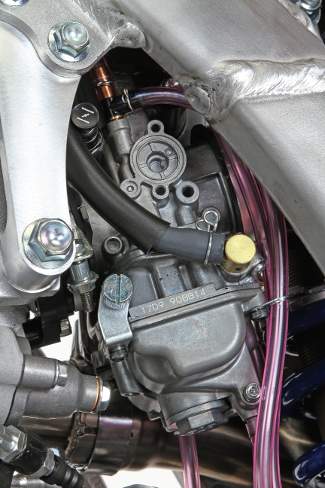 What’s that?: Kids probably won’t know what a carburetor is, but the YZ250F has one. We love the taper-bored Keihin. |
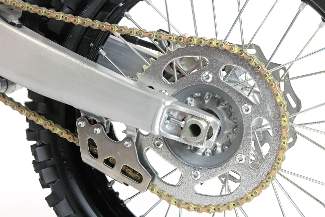 Bliss: After our incessent complaining Yamaha finally added a tooth to the YZ250F rear sprocket. 50 is better than 49. |
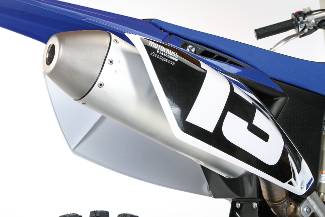 Hush: The YZ250F is incredibly quiet, but it comes at a price. That price? Horsepower. Invest in an aftermarket exhaust. |
Q: WHAT CHANGES WERE MADE TO THE 2012 YZ250F?
A: Yamaha left no stone unturned. They made refinements to the engine, chassis, suspension, carburetor, exhaust and even the chain. Aside from the Kawasaki KX250F, the Yamaha YZ250F is the most changed 250 four-stroke of the 2012 model year. Here’s the list of updates:
(1) Carburetor. Yamaha has remained true to the Keihin FCR carb. For 2012, the YZ250F gets a 2mm-larger carburetor bore (from 37mm to 39mm) for more top-end power (specifically from 8000 rpm to 12,000 rpm). In an effort to flow more air, Yamaha designed a larger air-filter cage, which mimics the inner shape of the air filter. Its volume has been increased by 50 percent. The CDI settings have also been revised. And, because the carb bore is larger, the throttle-tube cam pulls more throttle cable. (The throttle tube is also black instead of white.)
(2) Piston. The piston is 8.7-percent lighter than it was last year, thanks to a different rib configuration. The piston pin is not offset as it was in 2011. Additionally, the YZ250F gets piston rings with reduced friction and a lighter piston pin and circlips. These changes are aimed at improving engine performance by reducing reciprocating mass and friction while creating more power from 8000 rpm to 12,000 rpm.
(3) Crank. The crankshaft balancer and counterbalancer have been revised for smoother performance. Additionally, the connecting rod and big-end bearing get a new heat-treating process for more strength and improved durability. Overall, these updates target a reduction in vibration felt at the handlebars, seat and footpegs. Yamaha further tried to reduce vibration by redesigning the balancer shaft and balancer weight.
(4) Muffler. The muffler has an 8mm-smaller core that is designed to meet AMA and FIM sound standards.
(5) Drivetrain. Unlike in years past, when the YZ250F was equipped with a 49-tooth rear sprocket, the 2012 model comes with a 50-tooth sprocket. Also, the D.I.D. chain is now gold instead of black.
(6) Frame. The 2012 Yamaha YZ250F has a new frame that is composed of 20 different cast, forged, machined and extruded pieces. The frame rails are now triple-box extrusions instead of double-box extrusions for more rigidity. The width and thickness of the sections of the frame that house the swingarm pivot have been increased to support the rear suspension on all axes for more precise handling. The motor mounts have also been changed in thickness and shape. Yamaha’s goal was to make the YZ250F more predictable in rough conditions. The frame maintains the same geometry and dimensions as last year’s model.
(7) Forks. The Kayaba Speed Sensitive System (SSS) forks have been revalved to ride higher in their stroke (to lessen diving), and the spring rate has been increased from 0.45 kg/mm to 0.46 kg/mm. The outer fork tubes have been reshaped to provide better flex characteristics. The fork offset has been decreased from 25mm to 22mm. The steering-stem length has also been increased by 3mm for greater rigidity.
(8) Shock. The 46mm Kayaba SSS shock has revised damping and a slimmer 16mm shock shaft (it was 18mm). These changes improve bump absorption, and the refined damping characteristics allow the rider to attack rough sections with more confidence.
(9) Swingarm. The axle blocks at the back of the swingarm have been beefed up to increase the rigidity of the rear axle.
(10) Rims/tires. The Excel rims have been anodized black (they were silver in 2011), and the 2012 YZ250F will come equipped with Dunlop Geomax MX51 tires.
Q: WHAT WERE WE HOPING THAT YAMAHA WOULD CHANGE ON THE 2012 YZ250F?
A: You probably think that we wish they had fuel-injected the YZ250F. Nope. To put it simply, the MXA wrecking crew hoped that Yamaha would introduce an all-new YZ250F engine for 2012. Don’t get us wrong; we respect the old engine, but it is getting long in the tooth. Compared to some of the new engines in use today, the YZ250F’s design is more Volvo than Lamborghini. It is pleasant, safe and reliable, but we’re itching to get behind the wheel of a Lambo.
Instead of designing an all-new 250cc four-stroke engine, Yamaha took a page out of the same old YZ250F play book and refined the aging powerplant like they have done so many times before. We can’t blame them for two reasons: (1) Aside from the broken intake-valve issue on the 2006 model, the YZ250F is the most durable engine in the 250F field. Yamaha didn’t want to throw the baby out with the bath water in a poor economy and introduce a new engine design fraught with potential maladies. Instead, they changed a host of parts (piston, rings, crankshaft and carburetor) to help breathe new life into the stalwart engine. (2) The struggling economy and piddling sales of offroad bikes over the last four years are not incentives for the bean counters at Yamaha to free up R&D money?especially when that money probably wouldn’t generate an increase in sales (unless the unemployment rate rebounds). Basically, Yamaha doesn’t want to waste ammo until the market gives it a target to shoot at.
Q: DID THE ENGINE CHANGES IMPROVE THE POWERBAND ON THE 2012 YZ250F?
A: Yes. But before you get all misty-eyed, know that the 2012 YZ250F powerband still has many of the same traits as the previous engine. In no way did the larger carb, rebalanced crank or lighter piston turn the old P40 Tomahawk into a new F22 Raptor.
In recent years, the YZ250F engine has excelled from the bottom end to the midrange. It lacked even a hint of top-end power, which is a shame, because 250cc four-strokes aren’t torqued around a track at 8000 rpm; they are screamed. For 2012, the powerband has an added dose of mid-and-up power. It’s not a screamer like the Kawasaki KX250F or Suzuki RM-Z250, but it can certainly hold its own against the competition from the bottom end (6000 rpm) through the midrange (9000 rpm).
We can boldly proclaim that the 2012 Yamaha YZ250F engine is the best YZ250F powerplant ever. Riders raved about an improved surge through the midrange.?Although the engine maintains the same basic personality, it definitely received a facelift. However, it’s not the best engine in the class. If you’re looking for a strong powerband that can do everything well (but not exceptionally well), then the 2012 YZ250F is for you.
Q: HOW DOES THE 2012 YAMAHA YZ250F COMPARE TO LAST YEAR’S MODEL ON THE DYNO?
A: Maximum horsepower on our 2012 YZ250F was 37.13 ponies at 11,500 rpm. Maximum torque was 19.55 foot-pounds. Last year, the YZ250F pumped out 35.88 horsepower at 11,500 rpm with 18.95 foot-pounds of torque. The 2012 engine has roughly a 2-horsepower advantage from 10,000 rpm through 11,200 rpm.
It makes sense that the 2012 engine climbs up the dyno curve quicker and with greater horsepower output given that Yamaha switched to a lighter piston, larger carb and lighter counter-balancers. In terms of pure horsepower, the 2012 Kawasaki KX250F is king at 39.55 ponies, the Honda CRF250 is next at 38.44 horses, the Suzuki RM-Z250 is third at 38.12 ponies, the Yamaha YZ250F is fourth at 37.13 ponies and the KTM 250SXF finishes last at 35.52 ponies.
Q: WHAT’S SO UNIQUE ABOUT THE 2012 YAMAHA YZ250F?
A: If we had been asked this same question five years ago, we would have mentioned the Kayaba SSS suspension. As for 2012, our focus has shifted to the 39mm Keihin FCR carburetor. The 2012 KTM 450SXF and YZ250F are the only models from the Big Five to come equipped with carburetors.
Electronic fuel injection has swept the industry, and we can’t blame the manufacturers for heading in that direction. Why?
(1) Economy of scale. Once you fuel-inject your 450, you might as well fuel-inject your 250, because it makes the per-unit cost less for the EFI parts.
(2) Simplicity of purpose. EFI takes all of the guesswork out of air/fuel delivery.
(3) Decreased labor. Humans, by nature, are lazy. No one wants to tear apart a carburetor and swap jets in order to get his motorcycle to run properly (only to do it again an hour later when atmospheric conditions have changed).
Electronic fuel injection makes things easier, but is it necessarily better technology than the tried-and-true carburetor? It is, without a doubt, higher up the technology scale than a vacuum-powered carburetor, but it is not better. In our experience, EFI flattened out the powerband of the Honda CRF250, KTM 250SXF and the Kawasaki KX250F (until they went to dual injectors in 2012). Many MXA test riders prefer the organic feel and on-demand fuel delivery of a carburetor (that is, when the bike is jetted properly).
In last year’s bike test we wrote, “Do we expect the 2012 YZ250F to be EFI equipped?” Our answer proves that we need to get a new crystal ball, because we predicted that Yamaha would fuel-inject the 2012 YZ250F. Then again, for years we’ve been saying that Yamaha needs to develop an all-new engine, and they’ve stuck to their guns.
Q: HOW IS THE JETTING ON THE 2012 YAMAHA YZ250F?
A: Since Yamaha increased the size of the carburetor bore from 37mm to 39mm, they had to make several jetting changes. Compared to last year, the 2012 YZ250F has a richer mainjet to flow more fuel?not just because of the bigger carb, but also because of the improved airflow through the new air filter.
Here are MXA’s recommended jetting specs (stock settings are in parentheses):
Mainjet: 185
Pilot: 38
Needle: NFPR
Clip position: 5th from top
Fuel screw: 1 turn out (2 turns out)
Leak jet: 95
Notes: We recommend turning in the fuel screw in hot conditions.
Q: DOES THE 2012 YAMAHA YZ250F PASS SOUND?
A: Manufacturers are taking sound regulations seriously, and Yamaha isn’t any different. In an effort to comply with the AMA’s 94 dB limit, the YZ250F muffler has an 8mm-smaller outlet. That is tiny. It’s no secret that miniaturizing the muffler core is detrimental to an engine’s low-end horsepower and throttle response. It does, however, abate the sound levels. Case in point, the 2012 Yamaha YZ250F hit 92.7 decibels at the AMA-mandated 5000-rpm sound test. As for the FIM two-meter-max test, the YZ250F would pass the 115 dB test by virtue of the correction factor.
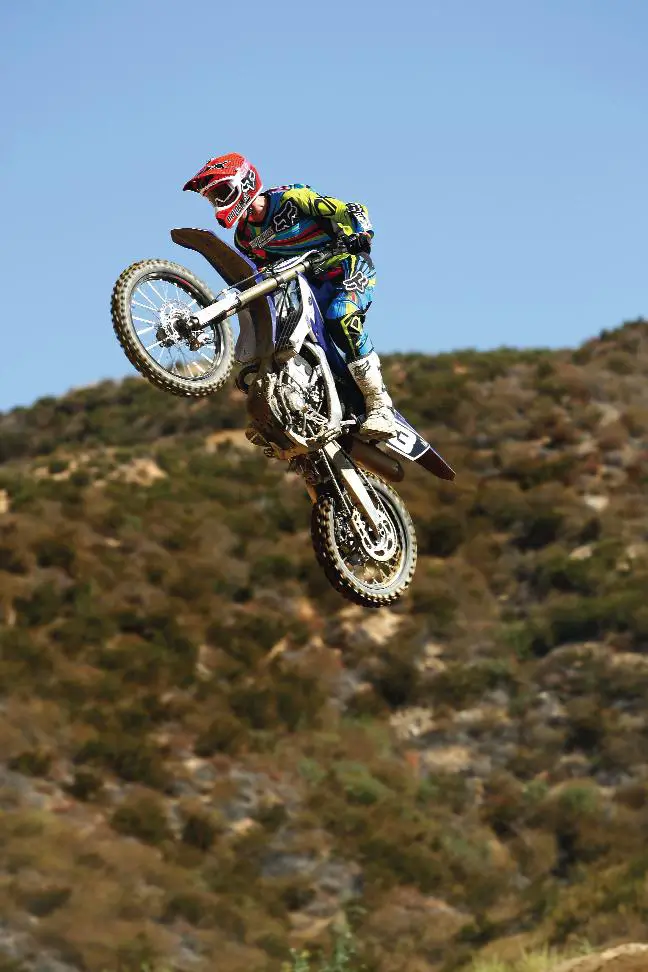
Q: WHAT IS THE RETAIL PRICE OF THE 2012 YAMAHA YZ250F?
A: The 2012 Yamaha YZ250F comes in two color combinations?blue/white or white/red?and retails for $7250. Last year the white/red version cost $100 extra, but that extra charge was for the black anodized rims. Since every 2012 Yamaha comes with black rims, the price differential has been eliminated.
In comparison to the Kawasaki KX250F ($7399), Suzuki RM-Z250 ($7399), Honda CRF250 ($7420), KTM 250SXF ($7699) and TM MX250F ($7720), the Yamaha YZ250F is the least expensive. Bravo!
Q: WHAT ARE OUR BEST FORK SETTINGS?
A: Let’s preface our Kayaba SSS fork settings by giving a standing ovation to Yamaha’s research and development staff. Why? The blue crew acquiesced to our request for stiffer fork springs in 2011 by making them standard on the 2012 model. Last year, the forks had a tendency to move too quickly through their stroke and dive under hard braking. With stiffer fork springs, those problems have been solved. We feel that the stiffer 0.46 kg/mm fork springs cover a wide range of riders, both in terms of skill level and weight.
For hardcore racing, these are MXA‘s recommended 2012 Yamaha YZ250F fork settings (when changed, stock settings are in parentheses):
Spring rate: 0.46 kg/mm
Oil quantity: 340cc (345cc)
Compression: 9 clicks out (10 clicks out)
Rebound: 10 clicks out
Fork leg height: 5mm up
Notes: Several riders complained of midstroke harshness, so we drained 5cc of oil out of the forks. The lower oil height made the forks more supple for slower riders, while Pro-level racers didn’t mind the stock oil height.
Q: WHAT ARE OUR BEST SHOCK SETTINGS?
A: Here is what the MXA wrecking crew ran in its 2012 YZ250F (stock settings, when changed, are in parentheses):
Spring rate: 5.3 kg/mm
Race sag: 100mm
Hi-compression: 2 turns out (1-3/4 turns out)
Lo-compression: 10 clicks out (8 clicks out)
Rebound: 12 clicks out (14 clicks out)
Notes: We noticed that the shock had a tendency to hop under heavy breaking and down rough straights. We slowed down the high-speed compression and softened the low-speed compression.
Q: WHAT DID WE DO TO MAKE THE YAMAHA YZ250F WORK BETTER?
A: The 2012 YZ250F doesn’t have very many peccadilloes, but there are a few chinks in the armor. Find satisfaction after making these investments:
(1) Exhaust pipe. Any motocross bike will benefit from a good aftermarket exhaust system, but it’s especially true with the 2012 YZ250F. Yamaha’s choked-down muffler core is for sound, not performance. Drop-kick the stock exhaust system, which also happens to be quite heavy, for a high-performance aftermarket exhaust and you’ll see a boost in midrange and top-end power.
(2) Intake system. Although Yamaha increased the volume of their air-filter cage, we still think that there’s room for improvement (no pun intended). Moto Tassinari sells a tunable intake system called the Air4orce that improves throttle response, creates a quicker transition across the low end and provides more midrange pull. It was good enough for a one-horsepower gain on the 2011 YZ250F and earned a five-star review.

Q: WHAT DO WE HATE?
A: The hate list:
(1) Exhaust. Maybe it’s just us, but exhaust pipes are suppose to enhance performance?not hinder it.
(2) Engine. We don’t hate the YZ250F powerplant, but the YZ250F has needed a high-revving power monger of an engine for so long that we won’t be satisfied until we get it. Maybe next year?
(3) Rims. Yamaha went the black-rim route on the blue model YZ250F (the white/red version already came with black rims). We like the Excel rims, but we miss the silver. The black rims get scratched and ugly looking in a few tire changes.
Q: WHAT DO WE LIKE?
A: The like list:
(1) Frame. Yamaha isn’t afraid to change their frame geometry. They made several major revisions in 2010, and for 2012, the frame has a new tank-rail cross-section type, swingarm pivot section and engine brackets. In turn, the YZ250F has improved rigidity and handling traits.
(2) Gearing. Yamaha finally went to the appropriate amount of teeth on the rear sprocket. The 50-tooth rear works well on all but Supercross-style tracks. Good stuff.
(3) Carburetor. Although we’re going against popular opinion, we’ve come to love the Keihin FCR carb. We commend Yamaha for upping the size of the carburetor bore (this is the same mod that the Star Racing team uses) to help boost power. Additionally, aside from a fuel-screw tweak, we didn’t have any problems with the stock jetting.
(4) Tires. We’ve said it before, and we’ll say it again. We love the tire pairing that comes on the YZ250F. The Bridgestone 403A front, which is YZ250F-specific, mated with the 404 rear is tire nirvana. These are the best sneakers in the business.
(5) Forks. Last year, the forks were too soft. This year, Yamaha spec’ed the changes we made to our 2011 fork (maybe that’s because they went with us when we tested fork settings).
(6) Durability. The YZ250F is the longest-lasting 250 four-stroke on the market. If you’re hard on equipment or short on greenbacks, the YZ250F is for you.
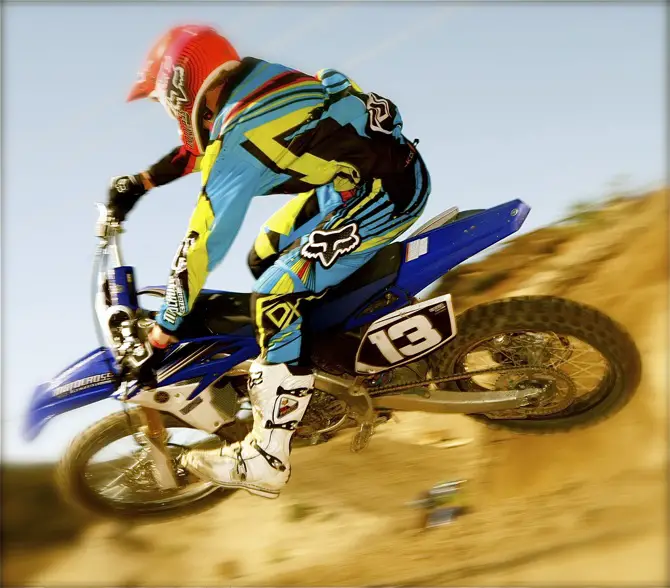
Q: WHAT DO WE REALLY THINK?
A: We have always liked the Yamaha YZ250F, but we could never come to terms with Yamaha’s insistence on putting a low-to-mid powerband in a bike that so badly needed a mid-and-up powerband. For 2012, Yamaha took one small step toward the proper power placement. Maybe next year they will take a giant leap for mankind.





Comments are closed.